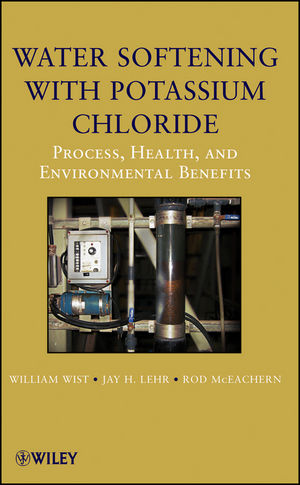Water Softening with Potassium Chloride: Process, Health, and Environmental BenefitsISBN: 978-0-470-08713-8
Hardcover
240 pages
October 2009
 This is a Print-on-Demand title. It will be printed specifically to fill your order. Please allow an additional 10-15 days delivery time. The book is not returnable.
|
||||||
PREFACE xi
ACKNOWLEDGMENTS xiii
1 WHAT IS POTASSIUM CHLORIDE? 1
Saskatchewan Potash History 2
Potash Mining 3
Solution Mining 9
Processing Potash Ore 13
Storage, Transportation, and Distribution of Potash 27
Potash Products 29
2 WHAT IS HARD WATER? 34
Definition of Hard Water 34
How Hard Water is Created 35
Problems Associated With Hard Water 37
How Hard Water is Measured 39
Uniform Degrees of Hardness 40
Types of Hardness 40
3 LOWERING WATER HARDNESS 43
Ion Exchange 44
Deionization or Demineralization 45
Reverse Osmosis 47
Distillation 49
Precipitation 50
4 THE ION EXCHANGE PROCESS 54
Synthesis and Structure of Ion Exchange Resins 55
Types of Ion Exchange Resins 56
Household Water Softening 57
Typical Household Water Softeners 59
Cocurrent and Countercurrent Regeneration 64
Mathematical Treatment of Ion Exchange Equilibria 66
Selectivity of Ion Exchange Reactions 75
5 BASIC CHEMISTRY OF ION EXCHANGE 78
The Building Blocks of Matter 78
Atomic and Molecular Weights 80
Cations and Anions 83
Chemical Reactions 84
6 OPERATION AND TYPES OF WATER SOFTENERS 86
Historical Methods of Regeneration 86
Operation of a Typical Water Softener 87
Common Sequences of Cycles 93
Types of Water Softeners 93
Sizing a Water Softener 96
7 POTASSIUM CHLORIDE REGENERANT FOR WATER SOFTENING 99
Alternate Regenerants 99
Potassium Chloride Regenerant 101
Initial Comparison of KCl and NaCl 102
Challenges When Using KCl as a Regenerant 110
Frequently Asked Questions 112
8 COMPARISON OF KCl AND NaCl AS REGENERANT 115
Definition of Terms 115
Theoretical Capacities of KCl and NaCl Regenerants 118
Calculation of Regeneration Efficiency 120
Sizing a Softener for Salt Efficiency 121
Implications for Salt Consumption 123
Total Salt Released to the Environment 127
Comparison of KCl and NaCl: Solubility 129
Comparison of KCl and NaCl: Speed of Dissolution 130
Comparison of KCl and NaCl: Capacity 132
Comparison of KCl and NaCl: Used and Unused Regenerant 135
Comparison of KCl and NaCl: Release of Chlorides to the Environment 138
Comparison of KCl and NaCl: Taste 139
Comparison of KCl and NaCl: Generation of Fines 144
Comparison of KCl and NaCl: Sodium Content of Softened Water 145
Comparison of KCl and NaCl: Potassium Content of Softened Water 154
Comparison of KCl and NaCl: Total Dissolved Solids 154
9 ENVIRONMENTAL CONSIDERATIONS 157
Potassium versus Sodium: Impact on Soil 159
Potassium versus Sodium: Impact on Septic Systems 162
Potassium versus Sodium: Impact on Sewage Treatment Systems 164
Potassium versus Sodium: Sewage Sludge 166
Potassium versus Sodium: Algae Growth 166
Potassium versus Sodium: Impact on Plants and Animals 169
Potassium versus Sodium: Use of Recycled Graywater 170
Recycling Regenerant Wastewater 171
Use of Regenerant Wastewater Studies at University of California, Davis 172
In Conclusion 177
10 POTASSIUM AND HUMAN HEALTH 183
Overview 183
Introduction 184
Cellular Physiology of Potassium 184
Potassium Balance 186
Defects in Potassium Elimination 188
Medical Conditions Related to Potassium Excess 189
Medical Conditions Related to Potassium Deficit 191
Indirect Role of Potassium in Health 199
Summary 200
11 ONGOING RESEARCH 209
Iron and Manganese Removal 209
Grade of KCl Regenerant 213
Cocurrent versus Countercurrent Regeneration 215
Portable Exchange Tanks 217
Research into Alternate Regenerants 220
APPENDIX 1 STANDARD TEST PROTOCOL FOR COMPARISON OF KCl AND NaCl REGENERANTS 223
Protocol Development 223
Standard Test Protocol 226
APPENDIX 2 LABORATORY DATA OBTAINED WITH THE STANDARD TEST PROTOCOL 233
APPENDIX 3 ACCELERATED MUSH TEST 243
Apparatus 243
Method 244
INDEX 245



